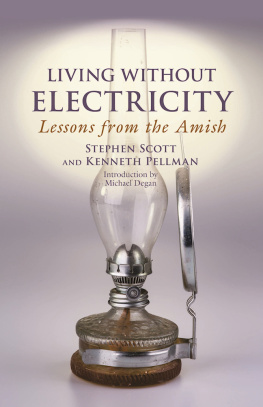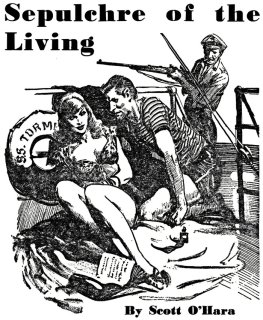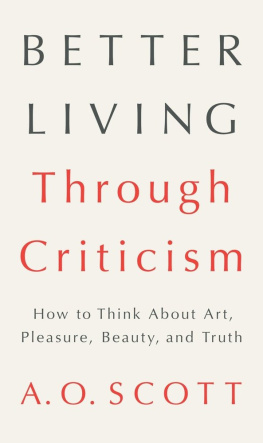Stephen Scott - Living Without Electricity
Here you can read online Stephen Scott - Living Without Electricity full text of the book (entire story) in english for free. Download pdf and epub, get meaning, cover and reviews about this ebook. year: 2016, publisher: Good Books, genre: Religion. Description of the work, (preface) as well as reviews are available. Best literature library LitArk.com created for fans of good reading and offers a wide selection of genres:
Romance novel
Science fiction
Adventure
Detective
Science
History
Home and family
Prose
Art
Politics
Computer
Non-fiction
Religion
Business
Children
Humor
Choose a favorite category and find really read worthwhile books. Enjoy immersion in the world of imagination, feel the emotions of the characters or learn something new for yourself, make an fascinating discovery.
- Book:Living Without Electricity
- Author:
- Publisher:Good Books
- Genre:
- Year:2016
- Rating:5 / 5
- Favourites:Add to favourites
- Your mark:
- 100
- 1
- 2
- 3
- 4
- 5
Living Without Electricity: summary, description and annotation
We offer to read an annotation, description, summary or preface (depends on what the author of the book "Living Without Electricity" wrote himself). If you haven't found the necessary information about the book — write in the comments, we will try to find it.
Living Without Electricity — read online for free the complete book (whole text) full work
Below is the text of the book, divided by pages. System saving the place of the last page read, allows you to conveniently read the book "Living Without Electricity" online for free, without having to search again every time where you left off. Put a bookmark, and you can go to the page where you finished reading at any time.
Font size:
Interval:
Bookmark:


Acknowledgments
Photo Credits
Beth Oberholtzer: .
Design by Dawn J. Ranck
LIVING WITHOUT ELECTRICITY
LESSONS FROM THE AMISH
Revised and Updated
Copyright 1990, 1999, 2016 by Good Books, New York, NY
All rights reserved. No part of this book may be reproduced in any manner without the express written consent of the publisher, except in the case of brief excerpts in critical reviews or articles. All inquiries should be addressed to Good Books, 307 West 36th Street, 11th Floor, New York, NY 10018.
Good Books books may be purchased in bulk at special discounts for sales promotion, corporate gifts, fund-raising, or educational purposes. Special editions can also be created to specifications. For details, contact the Special Sales Department, Good Books, 307 West 36th Street, 11th Floor, New York, NY 10018 or .
Good Books is an imprint of Skyhorse Publishing, Inc., a Delaware corporation.
Visit our website at www.goodbooks.com.
10 9 8 7 6 5 4 3 2 1
Library of Congress Cataloging-in-Publication Data is available on file.
Cover design by Jane Sheppard
Cover photo by iStock
Print ISBN: 978-1-68099-170-3
eBook ISBN: 978-1-68099-171-0
Printed in the United States of America
Table of Contents
Introduction
If you were to ask the average American what comes to mind when thinking about Amish characteristics, the answer would likely be that the Amish do not change. They look and live and think the same as they did a hundred years ago.
That image, of course, is fostered by mass media, much of which has little or no direct contact with Amish communities in North America. But for anyone who cares to dig deeper, the truth about the Amish is much more complex. The Amish do changebut carefully, slowly, and always in ways that protect each local communitys beliefs and values.
Change in the culture around the Amish encroaches on their communities in one way or another. But contrary to popular image, the Amish do not automatically reject things out of hand. Sometimes, if an advance can be helpful, Amish communities accept the change on their own terms. Often this means adapting a new technology in a way that harnesses its benefits while avoiding its dangers.
Additionally, each Amish district decides for itself how its members will live, behave, and practice their faith. There is no Amish pope who decides policy from on high for Amish everywhere.
Since this books first publication in 1990, the advent of computer and cell phone technology has presented unique challenges to the Amish of the 21st century. When the bans on telephone use and electricity from the public grid were established early in the 1900s, most Amish made their living in farming. As the Amish population grew (it doubles every twenty years) and farm land in many regions of North America became unavailable, many Amish families moved into other business, such as furniture-making or running small machine shops. The necessities of doing business, finding spare parts, communicating with customers, and so on are increasingly difficult, and in some cases impossible without the Internet. Amish communities once permitted members to use payphones, but today payphones are rare and have all but disappeared. The sight of Amish people of all ages talking on cell phones is no longer an anomaly. The computer has also become a necessary tool to conduct business so that Amish families can support themselves.
These realities and others present Old Order Amish communities with unforeseen challenges to their faith and values. The relationship between the Amish and the world of their non-Amish neighbors is a continual balancing act. As this book shows, the Amish have found ingenious ways to adapt technology when necessary or useful, supported by centuries of experience in recognizing potential hazards to the faith and the social fabric of their close-knit communities.
If only the English could learn to practice such discernment.
Michael Degan
Lancaster, Pennslyvania
Why Not Electricity?
Most North Americans today would think it impossible to do without electricity. Indeed, for people throughout the industrialized world, the most basic of lifes activities rely upon through-the-wires power. Lighting, cooking, heating, grooming, computers, and entertainmentall require volts and watts.
But electricity is actually a very recent development. While electrical power was available to many city dwellers in the early 1900s, the majority of rural North Americans had no access to current until the 1930s or 40s. Many people who were alive during the first third of the 20th century will be able to identify with the accounts of Amish life in this book. Of course, to millions of people in the non-industrial nations, even the ways of the Amish may seem modern and luxurious.
A Connection With the World
What makes the Old Order Amish unique is not that they get along without electricity, but that they choose to do without it when it would be readily available. Most Amish see a link with electric wires as a connection with the worldthe world that the Bible tells them they are to be strangers and pilgrims in.
Unlike many North Americans, the Amish value simplicity and self-denial over comfort, convenience, and leisure. So they try to discern the long-range effects of an innovation before deciding whether to adopt it.

An Amish home stands visibly apart from the outside world. There are no power lines, telephone lines, or television antennas.
Early in the 20th century, the large majority of Amish leaders agreed that connecting to power lines would not be in the best interest of their communities. They did not make this decision because they thought electricity was evil in itself, but because easy access to it could lead to many temptations and the deterioration of church and family life. For similar reasons, the Amish refuse to own cars.
Forbidding electricity has prevented the need to make decisions on individual electrical devices, especially those used for entertainment and communication. Radio, television, and the Internet promote values that are directly opposed to those of the Amish. These influences cannot easily come into the home if the usual door of entrance is not present.
Batteries and Generators
While rejecting TV, Internet, and through-the-wires power, however, most Amish communities have accepted some use of battery-powered devices. All but the most conservative groups permit battery-operated clocks, watches, and flashlights. Calculators, electric shavers, and buggy lights that are powered by batteries are in wide use among the Amish, as are battery-operated electric fences which keep livestock from straying. In some areas, Amish dairy farmers have complied with milk company demands that they use battery-powered agitators in bulk milk tanks. Some Amish use solar generators to recharge these batteries.
In certain cases, electric generators may be used to operate equipment. Carpenters in some communities use portable generators to run their power tools, and many shops are equipped with welders operated by generators. Gasoline-powered generators are often used to charge 12-volt batteries. Occasionally, these batteries are connected to electric inverters to produce 100-volt current. Some Amish church districts allow businesses to run cash registers and typewriters in this way.
Font size:
Interval:
Bookmark:
Similar books «Living Without Electricity»
Look at similar books to Living Without Electricity. We have selected literature similar in name and meaning in the hope of providing readers with more options to find new, interesting, not yet read works.
Discussion, reviews of the book Living Without Electricity and just readers' own opinions. Leave your comments, write what you think about the work, its meaning or the main characters. Specify what exactly you liked and what you didn't like, and why you think so.













